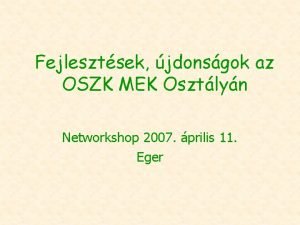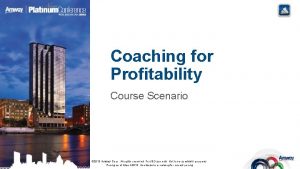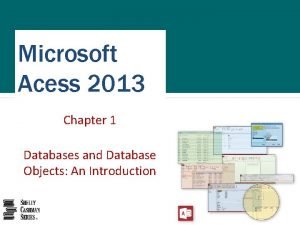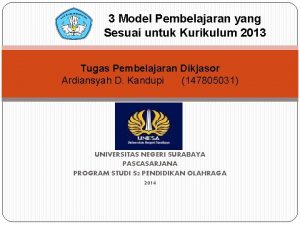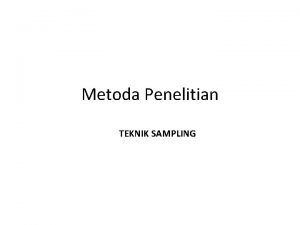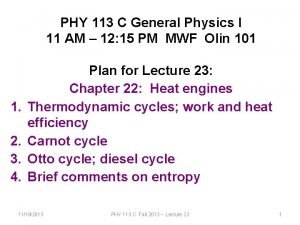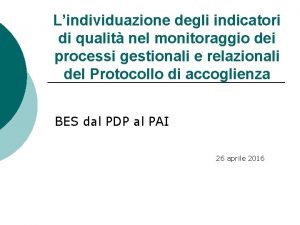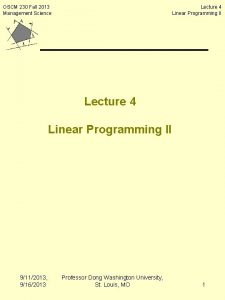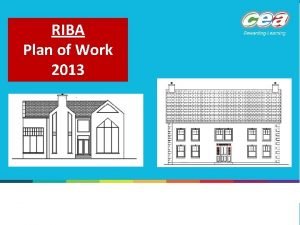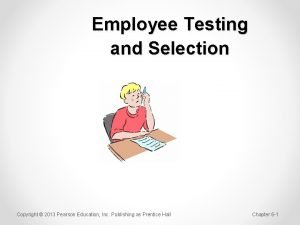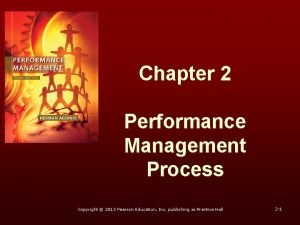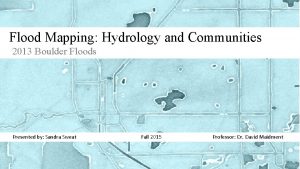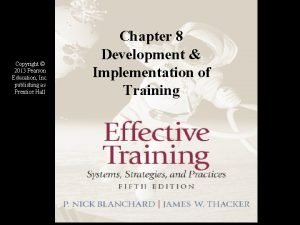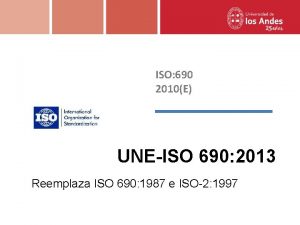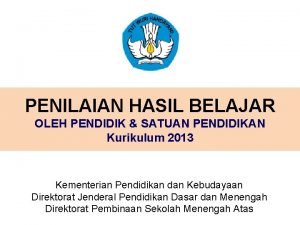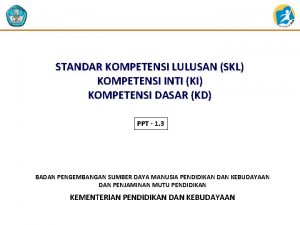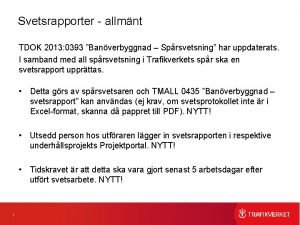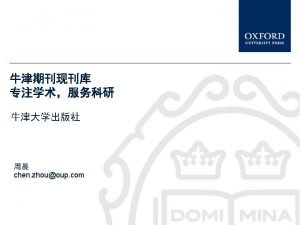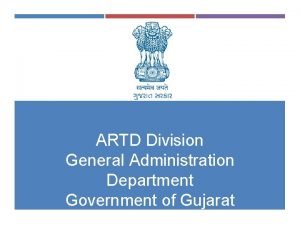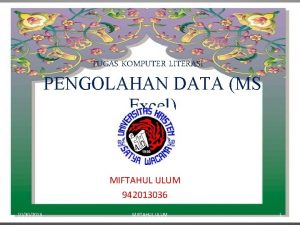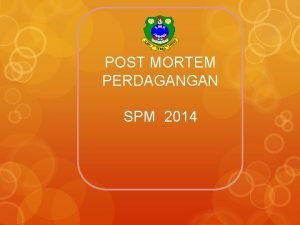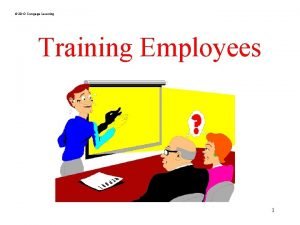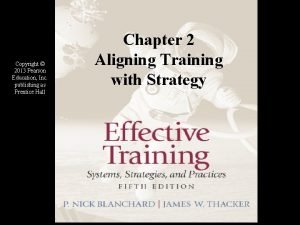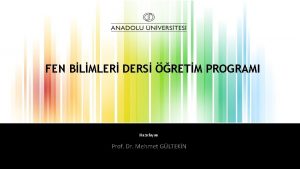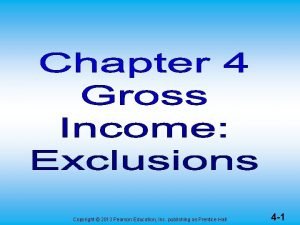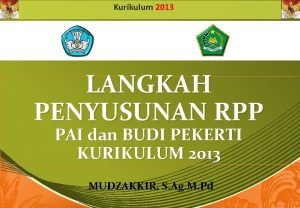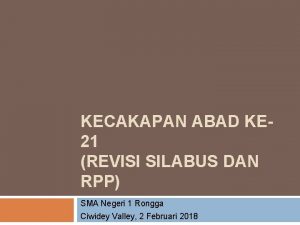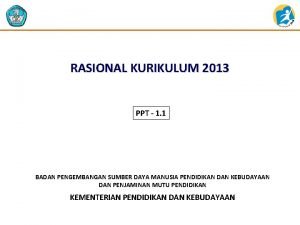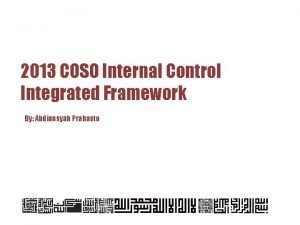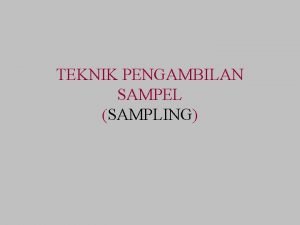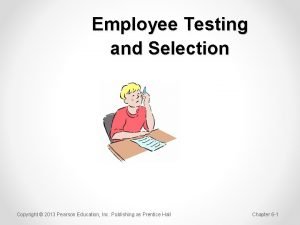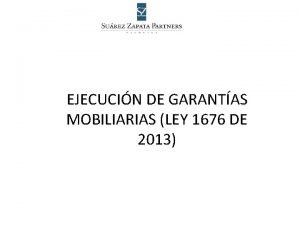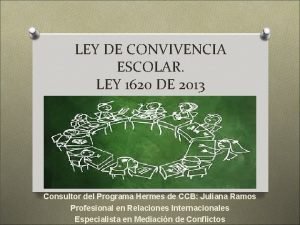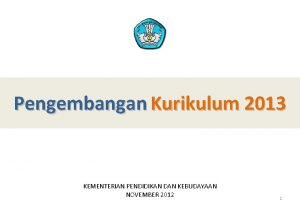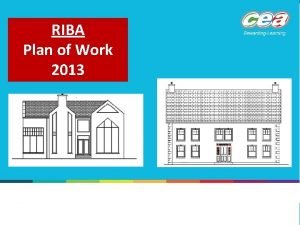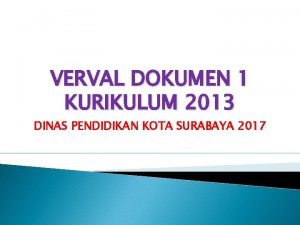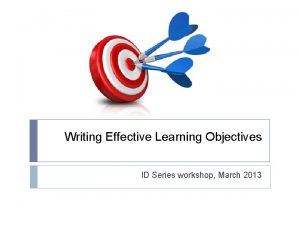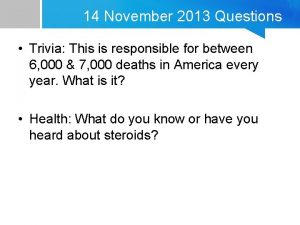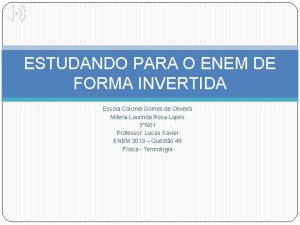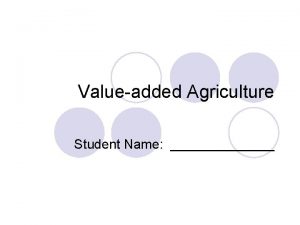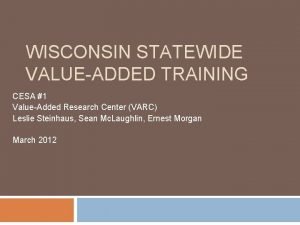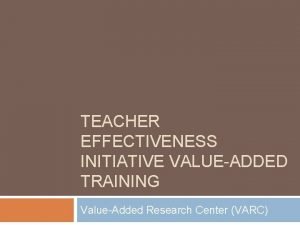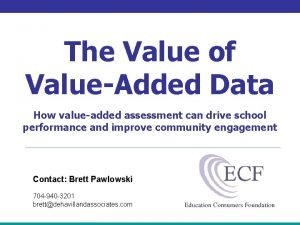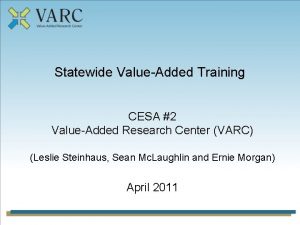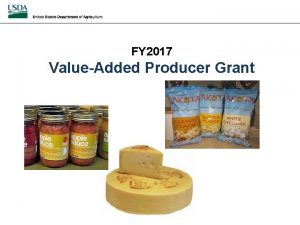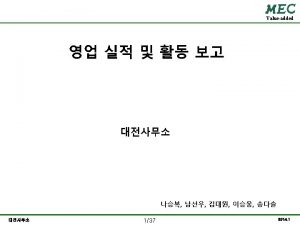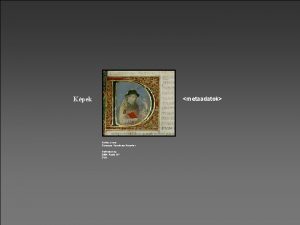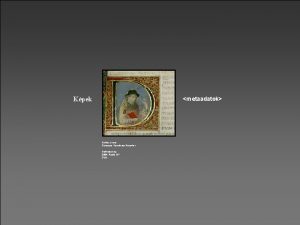VALUEADDED NETWORKSHOP May 2013 Agenda 8 30 10

































































































































- Slides: 129

VALUE-ADDED NETWORKSHOP May 2013

Agenda 8: 30 -10: 30 Value-Added Growth Model Overview and Refresher 10: 45 -11: 00 Welcome, Introductions 11: 00 -11: 30 Wisconsin Teacher Effectiveness 11: 30 -12: 00 Keynote Luncheon: Why Value. Added? 12: 00 -12: 45 Your Value-Added Reports 12: 45 -3: 15 Breakout Sessions (Pick 3) 3: 15 -3: 30 Networking, Wrap up, and Evaluation

Feedback Survey (for 8: 30 -10: 30 session) Please help us improve Value-Added training and resources for the future

VARC Introduction Review Sean Mc. Laughlin - VARC

Our Website: http: //varc. wceruw. org/ Go to Projects

Our Website: http: //varc. wceruw. org/ Wisconsin State-Wide

Our Website: http: //varc. wceruw. org/ May 2013 Value-Added Network Workshop

Districts and States Working with VARC NORTH DAKOTA MINNESOT A Minneapolis SOUTH DAKOTA WISCONSI N Milwaukee Madison NEW YORK Racine ILLINOIS Chicago New York City CALIFORNIA Tulsa OKLAHOMA Los Angeles Atlanta Hillsborough County Collier County

Achievement and Value-Added For the most complete picture of student and school performance, it is best to look at both Achievement and Value-Added. This will tell you: � What students know at a point in time (Achievement) � How your school is affecting student academic growth (Value-Added)

The Power of Two Achievement Compares students’ performance to a standard Does not factor in students’ background characteristics Measures students’ performance at a single point in time Critical to students’ postsecondary opportunities & A more complete picture of student learning Value-Added Measures students’ individual academic growth longitudinally Factors in students’ background characteristics outside of the school’s control Measures the impact of teachers and schools on academic growth Critical to ensuring students’ future academic success Adapted from materials created by Battelle for Kids

VARC Design Process: Continuous Improvement Objective • Valid and fair comparisons of teachers serving different student populations Stakeholder Feedback Model Co-Build • Model refinement • New objectives Output • Full disclosure: no blackbox • Model informed by technical and consequential validity • Productivity estimates (contribution to student academic growth) • Data formatting

The Oak Tree Analogy

The Oak Tree Analogy

Explaining Value-Added by Evaluating Gardener Performance For the past year, these gardeners have been tending to their oak trees trying to maximize the height of the trees. Gardener A Gardener B

Method 1: Measure the Height of the Trees Today (One Year After the Gardeners Began) Using this method, Gardener B is the more effective gardener. Gardener A This method is analogous to using an Achievement Model. 72 in. Gardener B 61 in.

Pause and Reflect How is this similar to how schools have been evaluated in the past? What information is missing from our gardener evaluation?

This Achievement Result is not the Whole Story We need to find the starting height for each tree in order to more fairly evaluate each gardener’s performance during the past year. 72 in. Gardener B Gardener A 61 in. 47 in. Oak A Age 3 (1 year ago) Oak A Age 4 (Today) 52 in. Oak B Age 3 (1 year ago) Oak B Age 4 (Today)

Method 2: Compare Starting Height to Ending Height Oak B had more growth this year, so Gardener B is the more effective gardener. Gardener A This is analogous to a Simple Growth Model, also called Gain. . 47 in. Oak A Age 3 (1 year ago) n. 61 in. i 4 +1 Oak A Age 4 (Today) 52 in. Oak B Age 3 (1 year ago) +2 n 0 i 72 in. Gardener B Oak B Age 4 (Today)

What About Factors Outside the Gardener’s Influence? This is an “apples to oranges” comparison. For our oak tree example, three environmental factors we will examine are: Rainfall, Soil Richness, and Temperature. Gardener A Gardener B

External condition Oak Tree A Oak Tree B Rainfall amount High Low Soil richness Temperature Gardener A Gardener B

How Much Did These External Factors Affect Growth? We need to analyze real data from the region to predict growth for these trees. We compare the actual height of the trees to their predicted heights to determine if the gardener’s effect was above or below average. Gardener A Gardener B

In order to find the impact of rainfall, soil richness, and temperature, we will plot the growth of each individual oak in the region compared to its environmental conditions.

Calculating Our Prediction Adjustments Based on Real Data Rainfall Low Medium High Growth in inches relative to the average -5 -2 +3 Soil Richness Low Medium High Growth in inches relative to the average -3 -1 +2 Temperature Low Medium High Growth in inches relative to the average +5 -3 -8

Make Initial Prediction for the Trees Based on Starting Height Next, we will refine out prediction based on the growing conditions for each tree. When we are done, we will have an “apples to apples” comparison of the gardeners’ effect. Gardener A 72 in. Gardener B 67 in. 52 in. 47 in. +20 Average Oak A Age 3 (1 year ago) Oak A Prediction Oak B Age 3 (1 year ago) Oak B Prediction

Based on Real Data, Customize Predictions based on Rainfall For having high rainfall, Oak A’s prediction is adjusted by +3 to compensate. Similarly, for having low rainfall, Oak B’s prediction is adjusted by -5 to compensate. Gardener A 67 in. Gardener B 70 in. 47 in. 52 in. +20 Average + 3 for Rainfall - 5 for Rainfall

Adjusting for Soil Richness For having poor soil, Oak A’s prediction is adjusted by -3. For having rich soil, Oak B’s prediction is adjusted by +2. Gardener A 69 in. Gardener B 67 in. 47 in. 52 in. +20 Average + 3 for Rainfall - 5 for Rainfall - 3 for Soil + 2 for Soil

Adjusting for Temperature For having high temperature, Oak A’s prediction is adjusted by -8. For having low temperature, Oak B’s prediction is adjusted by +5. 74 in. Gardener A 59 in. 47 in. Gardener B 52 in. +20 Average + 3 for Rainfall - 5 for Rainfall - 3 for Soil + 2 for Soil - 8 for Temp + 5 for Temp

Our Gardeners are Now on a Level Playing Field The predicted height for trees in Oak A’s conditions is 59 inches. The predicted height for trees in Oak B’s conditions is 74 inches. 74 in. Gardener A 59 in. 47 in. Gardener B 52 in. +20 Average + 3 for Rainfall - 5 for Rainfall - 3 for Soil + 2 for Soil - 8 for Temp _____ +12 inches During the year + 5 for Temp _____ +22 inches During the year

Compare the Predicted Height to the Actual Height Oak A’s actual height is 2 inches more than predicted. We attribute this to the effect of Gardener A. Oak B’s actual height is 2 inches less than predicted. We attribute this to the effect of Gardener B. Gardener A +2 59 in. Predicted Oak A Actual Oak A 74 in. -2 72 in. Gardener B 61 in. Predicted Oak B Actual Oak B

Method 3: Compare the Predicted Height to the Actual Height By accounting for last year’s height and environmental conditions of the trees during this year, we found the “value” each gardener “added” to the growth of the trees. This is analogous to a Value-Added measure. 74 in. Gardener A +2 61 in. 59 in. -2 72 in. Gardener B Above Average Value-Added Predicted Oak A Below Average Value-Added Actual Oak A Predicted Oak B Actual Oak B

Value-Added Basics – Linking the Oak Tree Analogy to Education

How does this analogy relate to value added in the education context? Oak Tree Analogy Value-Added in Education What are we evaluating? • Gardeners • Districts • Schools • Grades • Classrooms • Programs and Interventions What are we using to measure success? • Relative height improvement in inches • Relative improvement on standardized test scores Sample • Single oak tree • Groups of students Control factors • Tree’s prior height • Students’ prior test performance (usually most significant predictor) • Other factors beyond the gardener’s control: • Rainfall • Soil richness • Temperature • Other demographic characteristics such as: • Grade level • Gender • Race / Ethnicity • Low-Income Status • ELL Status • Disability Status • Section 504 Status

Another Visual Representation The Education Context Actual student achievement scale score Value. Added Starting student achievement scale score Predicted student achievement (Based on observationally similar students) Year 1 (Prior-test) Year 2 (Post-test)

Oak Tree Analogy Expansion (preview of optional resource materials for frequently asked questions) 1. What about tall or short trees? � (high 2. or low achieving students) How does VARC choose what to control for? � (proxy 3. measurements for causal factors) What if a gardener just gets lucky or unlucky? � (groups 4. of students and confidence intervals) Are some gardeners more likely to get lucky or unlucky? � (statistical shrinkage)

1. What about tall or short trees? (High or low achieving students)

1. What about tall or short trees? • If we were using an Achievement Model, which gardener would you rather be? • How can we be fair to these gardeners in our Value-Added Model? 93 in. Gardener D Gardener C 28 in. Oak C Age 4 Oak D Age 4

Why might short trees grow faster? • More “room to grow” • Easier to have a “big impact” Why might tall trees grow faster? • Past pattern of growth will continue • Unmeasured environmental factors How can we determine what is really happening? Gardener D Gardener C Oak C Age 4 Oak D Age 4

In the same way we measured the effect of rainfall, soil richness, and temperature, we can determine the effect of prior tree height on growth. The Effect of Prior Tree Height on Growth from Year 4 to 5 (inches) 40 30 in 9 in 35 30 25 20 Prior Tree. . . 15 10 5 0 0 20 40 60 80 100 120 Oak C Oak D Prior Tree Height (Year 4 Height in Inches) (28 in) (93 in)

Our initial predictions now account for this trend in growth based on prior height. • The final predictions would also account for rainfall, soil richness, and temperature. . in 0 3 + How can we accomplish this fairness factor in the education context? n. i 9 + Oak C Age 4 Oak C Age 5 (Prediction) Oak D Age 4 Oak D Age 5 (Prediction)

Analyzing test score gain to be fair to teachers Student 3 rd Grade Score 4 th Grade Score Abbot, Tina 244 279 Acosta, Lilly 278 297 Adams, Daniel 294 301 Adams, James 275 290 df Allen, Susan 312 323 Alvarez, Jose 301 313 Alvarez, Michelle 256 285 Anderson, Chris 259 277 Anderson, Laura 304 317 Anderson, Steven 288 308 Andrews, William 238 271 Atkinson, Carol 264 286 Test Score Range High Achiever Low

If we sort 3 rd grade scores high to low, what do we notice about the students’ gain from test to test? 3 rd Grade Score 4 th Grade Score Gain in Score from 3 rd to 4 th Allen, Susan 312 323 11 Anderson, Laura 304 317 13 Alvarez, Jose 301 313 12 Adams, Daniel 294 301 7 Anderson, Steven 288 308 20 Acosta, Lilly 278 297 19 Adams, James 275 290 15 Atkinson, Carol 264 286 22 Anderson, Chris 259 277 18 Alvarez, Michelle 256 285 29 Abbot, Tina 244 279 35 Andrews, William 238 271 33 Student Test Score Range High Low

If we find a trend in score gain based on starting point, we control for it in the Value. Added model. 3 rd Grade Score 4 th Grade Score Gain in Score from 3 rd to 4 th Allen, Susan 312 323 11 Anderson, Laura 304 317 13 Alvarez, Jose 301 313 12 Adams, Daniel 294 301 7 Anderson, Steven 288 308 20 Acosta, Lilly 278 297 19 Adams, James 275 290 15 Atkinson, Carol 264 286 22 Anderson, Chris 259 277 18 Alvarez, Michelle 256 285 29 Abbot, Tina 244 279 35 Andrews, William 238 271 33 Student Test Score Range High Low Gain High Low

What do we usually find in reality? Looking purely at a simple growth model, high achieving students tend to gain about 10% fewer points on the test than low achieving students. In a Value-Added model we can take this into account in our predictions for your students, so their growth will be compared to similarly achieving students.

Comparisons of gain at different schools before controlling for prior performance School A School B School C Student Population Advanced Proficient Basic Minimal High Achievement Artificially lower gain Medium Achievement Low Achievement Artificially inflated Why isn’t this fair?

Comparisons of Value-Added at different schools after controlling for prior performance School A School B School C Student Population Advanced Proficient Basic Minimal Fair

Checking for Understanding What would you tell a teacher or principal who said Value-Added was not fair to schools with: � High-achieving students? � Low-achieving students? Is Value-Added incompatible with the notion of high expectations for all students?

2. How does VARC choose what to control for? (Proxy measures for causal factors)

2. How does VARC choose what to control for? • Imagine we want to evaluate another pair of gardeners and we notice that there is something else different about their trees that we have not controlled for in the model. • In this example, Oak F has many more leaves than Oak E. • Is this something we could account for in our predictions? 73 in. Gardener F Gardener E Oak E Age 5 Oak F Age 5

In order to be considered for inclusion in the Value. Added model, a characteristic must meet several requirements: Check 1: Is this factor outside the gardener’s influence? Check 2: Do we have reliable data? Check 3: If not, can we pick up the effect by proxy? Check 4: Does it increase the predictive power of the model?

Check 1: Is this factor outside the gardener’s influence? Outside the gardener’s influence Gardener can influence Starting tree height Pruning Rainfall Insecticide Soil Richness Watering Temperature Mulching Starting leaf number Nitrogen fertilizer

Check 2: Do we have reliable data? Category Measurement Coverage Yearly record of tree height Height (Inches) 100% Rainfall (Inches) 98% Soil Richness Plant Nutrients (PPM) 96% Temperature Average Temperature (Degrees Celsius) 100% Starting leaf number Individual Leaf Count 7% Canopy diameter Diameter (Inches) 97%

Check 3: Can we approximate it with other data? ? Category Measurement Coverage Yearly record of tree height Height (Inches) 100% Rainfall (Inches) 98% Soil Richness Plant Nutrients (PPM) 96% Temperature Average Temperature (Degrees Celsius) 100% Starting leaf number Individual Leaf Count 7% Canopy diameter Diameter (Inches) 97%

Canopy diameter as a proxy for leaf count • The data we do have available about canopy diameter might help us measure the effect of leaf number. • The canopy diameter might also be picking up other factors that may influence tree growth. • We will check its relationship to growth to determine if it is a candidate for inclusion in the model. Gardener F Gardener E 33 in. Oak E Age 5 55 in. Oak F Age 5

If we find a relationship between starting tree diameter and growth, we would want to control for starting diameter in the Value-Added model. The Effect of Tree Diameter on Growth from Year 5 to 6 (inches) 40 35 30 ? 25 20 15 10 5 0 0 20 40 60 80 Tree Diameter (Year 5 Diameter in Inches) Tree Diameter

If we find a relationship between starting tree diameter and growth, we would want to control for starting diameter in the Value-Added model. The Effect of Tree Diameter on Growth from Year 5 to 6 (inches) 40 35 30 25 20 Tree Diameter 15 10 5 0 0 20 40 60 80 Tree Diameter (Year 5 Diameter in Inches)

What happens in the education context? Check 1: Is this factor outside the school or teacher’s influence? Check 2: Do we have reliable data? Check 3: If not, can we pick up the effect by proxy? Check 4: Does it increase the predictive power of the model?

Check 1: Is this factor outside the school or teacher’s influence? Outside the school’s influence School can influence At home support Classroom teacher English language learner status School culture Gender Math pull-out program at school Household financial resources Structure of lessons in school Learning disability Safety at the school Curriculum Prior knowledge Let’s use “Household financial resources” as an example

Check 2: Do we have reliable data? What we want • Household financial resources

Check 3: Can we approximate it with other data? What we want • Household financial resources What we have • Free / reduced lunch status Related data Using your knowledge of student learning, why might “household financial resources” have an effect on student growth? Check 4: “Does it increase the predictive power of the model? ” will be determined by a multivariate linear regression model based on real data from your district or state (not pictured) to determine whether FRL status had an effect on student growth.

What about race/ethnicity? Race/ethnicity causes higher or lower performance What we want What we have • General socio-economic • Race/ethnicity status • Family structure • Family education • Social capital • Environmental stress Related complementary data may correlate with one another (not a causal relationship) Check 4 will use real data from your district or state to determine if race/ethnicity has an effect on student growth. If there is no effect, we decide with our partners whether to leave it in.

What about race/ethnicity? If there is a detectable difference in growth rates We attribute this to a district or state challenge to be addressed When a teacher generates higher growth than other teachers serving similar students, it is accurate and fair to identify him/her as a high performing teacher.

Checking for Understanding What would you tell a 5 th grade teacher who said they wanted to include the following in the Value-Added model for their results? : A. B. C. D. 5 th grade reading curriculum Their students’ attendance during 5 th grade Their students’ prior attendance during 4 th grade Student motivation Check 1: Is this factor outside the school or teacher’s influence? Check 2: Do we have reliable data? Check 3: If not, can we pick up the effect by proxy? Check 4: Does it increase the predictive power of the model?

3. What if a gardener just gets lucky or unlucky? (Groups of students and confidence intervals)

3. What if a gardener just gets lucky or unlucky? Gardener G Oak A predicted growth: 10 inches Oak A Age 3 (1 year ago) Predicted Oak A

Gardener G Oak A actual growth: 2 inches For an individual tree, our predictions do not account for random events. Oak A Age 3 (1 year ago) Actual Oak A

Gardeners are assigned to many trees Gardener G Each tree has an independent prediction based on its circumstances (starting height, rainfall, soil richness, temperature)

How confident would you be about the effect of these gardeners? Gardener G Total trees assigned Trees that missed predicted growth Trees that beat predicted growth 5 3 2 Due to unlucky year Due to gardener Due to lucky year 1 2 0 2 Gardener H Total trees assigned Trees that missed predicted growth Trees that beat predicted growth 50 30 20 Due to unlucky year 7 Due to gardener Due to lucky year 23 15 5

Reporting Value-Added In the latest generation of Value-Added reports, estimates are color coded based on statistical significance. This represents how confident we are about the effect of schools and teachers on student academic growth. Green and Blue results areas of relative strength. Student growth is above average. Gray results are on track. In these areas, there was not enough data available to differentiate this result from average. Yellow and Red results areas of relative weakness. Student growth is below average.

3 Value-Added is displayed on a 1 -5 scale for reporting purposes. Grade 4 30 About 95% of estimates will fall between 1 and 5 on the scale. 3. 0 represents Numbers lower than meeting predicted Numbers higher than 3. 0 represent growth for your 3. 0 represent growth that did not meet students. that beat prediction. Since predictions are Students are learning Students are still based on the actual at a rate faster than learning, but at a rate performance of predicted. slower than students in your predicted. district or state, 3. 0 also represents the district or state average growth for students similar to yours.

3 READING Grade 4 30 3. 8 95% Confidence Interval Value-Added estimates are provided with a confidence interval. Based on the data available for these thirty 4 th Grade Reading students, we are 95% confident that the true Value-Added lies between the endpoints of this confidence interval (between 3. 2 and 4. 4 in this example), with the most likely estimate being 3. 8.

Confidence Intervals Color coding is based on the location of the confidence interval. The more student data available for analysis, the more confident we can be that growth trends were caused by the teacher or school (rather than random events). 3 READING Grade 3 13 4. 5 Grade 4 36 4. 5 Grade 5 84 4. 5 3 MATH Grade 3 13 1. 5 Grade 4 36 1. 5 Grade 5 84 1. 5

Checking for Understanding A teacher comes to you with their Value-Added report wondering why it’s not a green or blue result. She wants to know why there’s a confidence interval at all when VARC had data from each and every one of her students. (Don’t we know exactly how much they grew? ) 3 READING Grade 7 11 4. 2

4. Are Some Gardeners More Likely to Get Lucky or Unlucky? (Statistical Shrinkage)

The Previous “Unlucky Gardener” Example Our example gardener had low growth for a tree due to an unforeseen factor. We use confidence intervals to show confident we are that growth is due to the gardeners. More assigned trees means tighter confidence intervals.

Can We Improve Our Estimates? Unfair low measured growth due to “unlucky” factors More accurate measurement of true contribution to growth Unfair high measured growth due to “lucky” factors

Gardener Effectiveness Imagine we were able to measure definitively the true effectiveness of every gardener. We might expect to find most gardeners close to average with fewer as we get to the extremes. Low Effectiveness Average Effectiveness High

A Bell Curve of Effectiveness We can imagine this true distribution of gardener effectiveness as a bell curve. True Variance of Gardener Effects Low Effectiveness Average Effectiveness High

A Bell Curve of Effectiveness What happens when we add in “lucky” and “unlucky” factors (statistical estimation error)? True Variance of Gardener Effects Variance Including Estimation Error Gardeners with low growth due to “unlucky” factors Low Effectiveness Gardeners with high growth due to “lucky” factors Average Effectiveness High

The Effect of Estimation Error Increases with Fewer Data Points Gardeners with 50 trees Solution: Shrinkage Estimation Low Effectiveness Average Effectiveness High Gardeners with 5 trees True Variance of Gardener Effects Variance Including Estimation Error

Why Use Statistical Shrinkage Estimation in the Education Context? Without shrinkage, small schools and classrooms would be falsely overrepresented in the highest and lowest Value-Added categories. Shrinkage improves the accuracy and precision of Value-Added estimates by adjusting for the wider variance that occurs simply as a result of teaching fewer students. Shrinkage increases the stability of Value. Added estimates from year to year.

The Effect of Statistical Shrinkage on a Value-Added Report NUMBER OF STUDENTS (WEIGHTED) VALUE-ADDED ESTIMATES 1 2 4 3 MATH Grade 3 20. 0 Grade 4 40. 0 Grade 5 60. 0 1. 7 2. 4 3. 8 4. 3 1. 61. 9 Before After Shrinkage 5

The Estimates on Your Report Already Include Statistical Shrinkage Estimates always moved closer to “average” Estimates were shrunk less when: � There were many students � The original (unshrunk) estimate was close to average Shrinkage is the reason simple “weighted averages” of Value-Added estimates do not match our reported aggregate numbers � Example: an Elementary School’s overall math is not simply the weighted average of each gradelevel math estimate

Checking for Understanding NUMBER OF STUDENTS (WEIGHTED) VALUE-ADDED ESTIMATES 1 2 3 READING School-Level Value-Added Overall 300 1. 5 MATH READING Grade-Level Value-Added Grade 3 100 Grade 4 100 Grade 5 100 2. 1 2. 3 1. 9 4 5 Using what you now know about shrinkage estimation, explain how it is possible for this elementary school’s overall average Value. Added to be reported lower than any of the individual gradelevel estimates.

Value-Added Estimate Color Coding

Value-Added Color Coding NUMBER OF STUDENTS (WEIGHTED) VALUE-ADDED ESTIMATES 1 2 3 MATH Grade 3 47. 1 Grade 4 39. 8 Grade 5 43. 0 1. 3 2. 5 1. 9 4 5

Value-Added Color Coding NUMBER OF STUDENTS (WEIGHTED) VALUE-ADDED ESTIMATES 1 2 3 4 5 READING Grade 4 63. 4 2. 7 95% Confidence Interval Based on the data available for these thirty 4 th grade reading students, we are 95% confident that the true Value-Added lies between the endpoints of this confidence interval (between 2. 1 and 3. 3 in this example), with the most likely estimate being 2. 7

Value-Added Color Coding NUMBER OF STUDENTS (WEIGHTED) VALUE-ADDED ESTIMATES 1 2 3 4 READING Grade 3 47. 5 Grade 4 44. 0 Grade 5 21. 9 3. 0 2. 5 4. 1 If the confidence interval crosses 3, the color is gray. 5

Value-Added Color Coding NUMBER OF STUDENTS (WEIGHTED) VALUE-ADDED ESTIMATES 1 2 5 4 3 READING Grade 3 45. 6 Grade 4 48. 2 Grade 5 33. 4 3. 8 4. 4 5. 1 If the confidence interval is entirely above 3, the color is green.

Value-Added Color Coding NUMBER OF STUDENTS (WEIGHTED) VALUE-ADDED ESTIMATES 1 2 3 5 4 READING Grade 3 58. 2 Grade 4 62. 5 Grade 5 60. 0 4. 7 5. 4 4. 9 If the confidence interval is entirely above 4, the color is blue.

Value-Added Color Coding NUMBER OF STUDENTS (WEIGHTED) VALUE-ADDED ESTIMATES 1 2 3 4 READING Grade 3 34. 2 Grade 4 31. 0 Grade 5 36. 0 2. 3 1. 6 2. 4 If the confidence interval is entirely below 3, the color is yellow. 5

Value-Added Color Coding NUMBER OF STUDENTS (WEIGHTED) VALUE-ADDED ESTIMATES 1 2 3 4 5 READING Grade 3 53. 0 Grade 4 58. 0 Grade 5 55. 5 0. 3 1. 1 1. 4 If the confidence interval is entirely below 2, the color is red.

Reporting Value-Added In the latest generation of Value-Added reports, estimates are color coded based on statistical significance. This represents how confident we are about the effect of schools and teachers on student academic growth. Green and Blue results areas of relative strength. Student growth is above average. Gray results are on track. In these areas, there was not enough data available to differentiate this result from average. Yellow and Red results areas of relative weakness. Student growth is below average.

Explain to your Neighbor Which grade 5 4 1 2 3 level team is MATH Grade-Level Value-Added most effective 1. 3 58. 7 at growing their Grade 3 68. 3 4. 1 Yellowstudents? or Red estimates are not. Grade 4 about 2. 8 55. 9 Grade 5 Can we tell “Naming, Shaming, and which group of Blaming” we want to students has If this was your school, how “Uncover, Discover, and the highest would you start talking about Recover” proficiency this data with your teaching as professional learning rate? communities teams? NUMBER OF STUDENTS (WEIGHTED) VALUE-ADDED ESTIMATES

Break (if time allows based on number of questions) 9: 35 -9: 45 After the break: If no objections, we will be recording for potential future resource use

Sample Report Review

Page 1 - Introduction Reporting Period and Context Table of Contents Color Coding Explanation

Page 2 – School-Level Value. Added and Grade-Level Value. Added Results School-Level Value-Added Estimates Grade-Level Value-Added Estimates

Page 2 Top School-Level Value-Added Past Academic Year 2011 -2012 NUMBER OF STUDENTS (WEIGHTED) Up-To-3 -Year Average VALUE-ADDED ESTIMATES 5 4 2 3 1 -5 Scale School-Level Value-Added Level of Analysis READING 182. 9 MATH 182. 9 Subje ct 1 VALUE-ADDED ESTIMATES 4 2 3 1 -5 Scale 1 559. 4 2. 5 559. 4 1. 6 Past Academic Year Number of students included in the analysis NUMBER OF STUDENTS (WEIGHTED) 2. 4 1. 7 Up-To-3 -Year Average Value-Added Estimate • Point Estimate (number in colorcoded bubble) • 95% Confidence Interval (black line) 5

Page 2 Bottom FAQ 1: Which school year is this? Grade-Level Value-Added Past Academic Year 2011 -2012 NUMBER OF STUDENTS (WEIGHTED) READING VALUE-ADDED ESTIMATES 1 2 4 3 5 NUMBER OF STUDENTS (WEIGHTED) VALUE-ADDED ESTIMATES 1 2 3 5 4 Grade-Level Value-Added Grade 3 58. 7 Grade 4 68. 3 Grade 5 55. 9 MATH Up-To-3 -Year Average 171. 9 2. 1 1. 9 187. 5 3. 3 4. 3 200. 1 2. 6 2. 1 Grade-Level Value-Added Grade 3 58. 7 Grade 4 68. 3 Grade 5 55. 9 171. 9 0. 7 1. 1 187. 5 1. 6 3. 8 200. 1 1. 8 4. 1

Value-Added on the WKCE Grade 3 Summe r Nov Grade 4 Nov 3 rd Grade Value-Added Grade 5 Summe r Nov 4 th Grade Value-Added Grade 6 Nov 5 th Grade Value-Added 4 th grade example: � � � Summe r “Starting knowledge” is the November 2011 4 th grade test. “Ending knowledge” is the November 2012 5 th grade test. This aligns to growth in the 2011 -2012 4 th grade school year. Why don’t we have 8 th grade Value-Added in Wisconsin?

FAQ 2: Page 2 Bottom How do I interpret the “Up-To-3 -Year Average”? Grade-Level Value-Added Past Academic Year 2011 -2012 NUMBER OF STUDENTS (WEIGHTED) READING VALUE-ADDED ESTIMATES 1 2 4 3 5 NUMBER OF STUDENTS (WEIGHTED) VALUE-ADDED ESTIMATES 1 2 3 5 4 Grade-Level Value-Added Grade 3 58. 7 Grade 4 68. 3 Grade 5 55. 9 MATH Up-To-3 -Year Average 171. 9 2. 1 1. 9 187. 5 3. 3 4. 3 200. 1 2. 6 2. 1 Grade-Level Value-Added Grade 3 58. 7 Grade 4 68. 3 Grade 5 55. 9 171. 9 0. 7 1. 1 187. 5 1. 6 3. 8 200. 1 1. 8 4. 1

What Does “Up-To-3 -Year Average” Mean for the 3 rd Grade? Represents the 3 rd grade teaching team over three cohorts of students Does not follow individual students for 3 years NOT Jimmy as he goes through three consecutive school years � 3 rd � � grade to grade growth 4 th grade to 5 th grade growth 5 th grade to 6 th grade growth 4 th 3 rd grade team with � 2009 -2010 cohort � 2010 -2011 cohort � 2011 -2012 cohort (3 rd grade to 4 th grade growth) Teaching teams may have changed over time: keep teacher mobility in mind

What Does “Up-To-3 -Year Average” Mean? Past Academic Year 2011 -2012 NUMBER OF STUDENTS (WEIGHTED) READING Up-To-3 -Year Average VALUE-ADDED ESTIMATES 1 2 3 4 5 NUMBER OF STUDENTS (WEIGHTED) 20 2011 -2012 3 rd Graders 60 Grade 4 20 2011 -2012 4 th Graders 60 Grade 5 20 2011 -2012 5 th Graders 60 1 2 3 4 Grade-Level Value-Added Grade 3 VALUE-ADDED ESTIMATES 09 -10 3 rd Gr. 09 -10 4 th Gr. 09 -10 5 th Gr. 10 -11 3 rd Gr. 10 -11 4 th Gr. 10 -11 5 th Gr. 11 -12 3 rd Gr. 11 -12 4 th Gr. 11 -12 5 th Gr. The “Past Academic Year” represents longitudinal growth over a single school year. The “Up-To-3 -Year Average” represents average longitudinal growth of three different groups of students at each grade level. 5

What Does “Up-To-3 -Year Average” Mean? Past Academic Year 2011 -2012 NUMBER OF STUDENTS (WEIGHTED) READING VALUE-ADDED ESTIMATES 1 2 5 4 3 NUMBER OF STUDENTS (WEIGHTED) VALUE-ADDED ESTIMATES 1 2 4 3 Grade-Level Value-Added Grade 3 48. 5 Grade 4 44. 5 Grade 5 46. 0 Up-To-3 -Year Average 146. 0 3. 4 3. 5 141. 1 0. 9 4. 1 4. 4 147. 8 2. 8 Which grade-level teaching team… � Was most effective in the 2011 -2012 school year? � Was most effective over the past three school years? � Was more effective in 2011 -2012 than in the past? 5

Page 2 Bottom Grade-Level Value-Added Past Academic Year 2011 -2012 NUMBER OF STUDENTS (WEIGHTED) READING VALUE-ADDED ESTIMATES 1 2 3 4 5 NUMBER OF STUDENTS (WEIGHTED) VALUE-ADDED ESTIMATES 1 2 3 5 4 Grade-Level Value-Added Grade 3 58. 7 Grade 4 68. 3 Grade 5 55. 9 MATH Up-To-3 -Year Average 171. 9 FAQ 3: Does this show student growth to go 187. 5 3. 3 from red to yellow to green over time? 2. 1 1. 9 4. 3 200. 1 2. 6 2. 1 Grade-Level Value-Added Grade 3 58. 7 Grade 4 68. 3 Grade 5 55. 9 171. 9 0. 7 1. 1 187. 5 1. 6 3. 8 200. 1 1. 8 4. 1

Value-Added, Not Achievement In your groups: � Describe this school’s math performance � Describe this school’s reading performance 3 MATH Grade 3 61 Grade 4 63 Grade 5 60 3. 8 3. 9 3 3. 9 READING Grade 3 61 Grade 4 63 Grade 5 60 4. 8 3. 0 1. 1

Page 2 Bottom FAQ 4: Grade-Level Value-Added Why are there non-integer numbers of students? Past Academic Year 2011 -2012 NUMBER OF STUDENTS (WEIGHTED) READING VALUE-ADDED ESTIMATES 1 2 4 3 5 NUMBER OF STUDENTS (WEIGHTED) VALUE-ADDED ESTIMATES 1 2 3 5 4 Grade-Level Value-Added Grade 3 58. 7 Grade 4 68. 3 Grade 5 55. 9 MATH Up-To-3 -Year Average 171. 9 2. 1 1. 9 187. 5 3. 3 4. 3 200. 1 2. 6 2. 1 Grade-Level Value-Added Grade 3 58. 7 Grade 4 68. 3 Grade 5 55. 9 171. 9 0. 7 1. 1 187. 5 1. 6 3. 8 200. 1 1. 8 4. 1

Mobile Students If a student is enrolled in more than one school between the November WKCE administration and the end of the school year, each school gets credit for a portion of the student’s growth. 55% Attributed to A School A 45% Attributed to B School B Grade 3 Nov WKCE End of School Year

Reasons Students are Dropped Lack of test scores � Example: To be included, students need consecutive WKCE scores Nov 2011 and Nov 2012 for the most recent run Lack of linkage to a school Student did not take the standard WKCE � Accommodations – these students are included � Keep in mind when interpreting student groups sections

Pages 3 & 4 – Student Group Results (a. k. a. “Differential Effects”) School-Level Value-Added Estimates for Student Group Disability Economic Status Gender English Proficiency

Student Group Results Also called “Differential Effects”, these results answer the following question: How effective was my school at growing certain groups of students?

Overall Results (Constant Effects) Prior Achievement (Scale Scores) FRL Status My School ELL Status (by category) SPED Status (by severity level) Race/Ethnicity Gender How much did my students grow compared to similar students from across Wisconsin? Now, to demonstrate student group results, let’s consider the student group “female”

Step 1: Reduce Sample to Just Females Prior Achievement (Scale Scores) FRL Status ELL Status My School Females at My School (by category) SPED Status (by severity level) Race/Ethnicity Gender Female students’ other demographic characteristics may be different than the school as a whole

Step 2: Student Group Results (Differential Effects): Gender = Female Prior Achievement (Scale Scores) FRL Status ELL Status Females at My School (by category) SPED Status (by severity level) Race/Ethnicity Gender How much did my female students grow compared to similar female students from across Wisconsin?

Scenario 1 Past Academic Year 2011 -2012 NUMBER OF STUDENTS (WEIGHTED) READING Female Up-To-3 -Year Average VALUE-ADDED ESTIMATES 1 2 3 4 5 NUMBER OF STUDENTS (WEIGHTED) VALUE-ADDED ESTIMATES 1 2 3 By Gender 40. 0 3. 9 ** Insufficient Data Female students at my school grew faster than similar female students from across Wisconsin 4 5

Scenario 2 Past Academic Year 2011 -2012 NUMBER OF STUDENTS (WEIGHTED) READING Female Up-To-3 -Year Average VALUE-ADDED ESTIMATES 1 2 3 4 5 NUMBER OF STUDENTS (WEIGHTED) VALUE-ADDED ESTIMATES 1 2 3 4 By Gender 40. 0 2. 8 ** Insufficient Data Female students at my school grew about the same as similar female students from across Wisconsin 5

Scenario 3 Past Academic Year 2011 -2012 NUMBER OF STUDENTS (WEIGHTED) READING Female Up-To-3 -Year Average VALUE-ADDED ESTIMATES 1 2 3 4 5 NUMBER OF STUDENTS (WEIGHTED) VALUE-ADDED ESTIMATES 1 2 3 By Gender 40. 0 1. 6 ** Insufficient Data Female students at my school grew slower than similar female students from across Wisconsin 4 5

Example Student Group Interpretation Past Academic Year 2011 -2012 NUMBER OF STUDENTS (WEIGHTED) READING With Disabilities Without Disabilities Up-To-3 -Year Average VALUE-ADDED ESTIMATES 1 2 3 4 5 NUMBER OF STUDENTS (WEIGHTED) VALUE-ADDED ESTIMATES 1 2 3 4 By Disability 3. 9 22. 0 160. 9 2. 3 ** Insufficient Data At this school which student group is growing faster than their similar peers from across the state? Does that mean the “With Disabilities” group grew more scale score points on the test than “Without Disabilities” group? If the “With Disabilities” group is green or blue, does that mean we are closing the achievement gap with this group? 5

Student Group Interpretation What Would You Do? Past Academic Year 2011 -2012 NUMBER OF STUDENTS (WEIGHTED) MATH VALUE-ADDED ESTIMATES 1 52. 0 0. 8 English Proficient 130. 9 2 3 4 5 NUMBER OF STUDENTS (WEIGHTED) VALUE-ADDED ESTIMATES 1 2 3 By English Proficiency LEP Up-To-3 -Year Average 2. 2 ** Insufficient Data What do these results mean? If this was your school, how could you use these results to monitor instructional improvement? 4 5

Page 5 – School-Level Scatter Plots School-Level Value-Added and Achievement Scatter Plot Interpretation

Overall Scatter Plots (Include new NAEP aligned proficiency cut scores)

How to Read the Scatter Plots These scatter plots are a way to represent Achievement and Value-Added together 80 Achievement Percent Prof/Adv (2011) 100 60 40 20 Value-Added 0 1 2 3 4 Value-Added (2011 -2012) 5

How to Read the Scatter Plots A. Students know a lot and are growing faster than predicted 100 Percent Prof/Adv (2011) C A 80 B. Students are behind, but are growing faster than predicted C. Students know a lot, but are growing slower than predicted E 60 D. Students are behind, and are growing slower than predicted E. Students are about average in how much they know and how fast they are growing 40 D 20 0 B 1 2 3 4 Value-Added (2011 -2012) 5 Schools in your district

Page 6 (and 7 for some schools) – Grade-Level Scatter Plots Grade-Level Value-Added and Achievement

Grade-Level Scatter Plots Grade 3 Reading Grade 3 Math

Last Section – Additional Information (1 of 2) 1 -5 Value-Added Scale Student Group Interpretation Number of Students (Weighted)

Last Section – Additional Information (2 of 2) Control Variables in the Model Reasons for “Insufficient Data or NA”

Feedback Survey (for 8: 30 -10: 30 session) Please help us improve Value-Added training and resources for the future

VARC Resources http: //varc. wceruw. org/Projects/wisconsin_statewide. php Content of these and other Power Points Narrated videos Online course preview Link to online reporting tool � Example Reports Example materials from other VARC projects
 Networkshop
Networkshop Agenda sistemica y agenda institucional
Agenda sistemica y agenda institucional Amway review 2013
Amway review 2013 Hci patterns
Hci patterns 5 mei 2013 hari apa
5 mei 2013 hari apa Akta pengurusan strata 2013
Akta pengurusan strata 2013 Acess 2013
Acess 2013 Model model pembelajaran kurikulum 2013
Model model pembelajaran kurikulum 2013 Rumus sampel arikunto 2013
Rumus sampel arikunto 2013 Madsciencelessons.com 2013
Madsciencelessons.com 2013 2013 core knowledge foundation
2013 core knowledge foundation Fiscal incentives for industrial promotion (revised)-2013
Fiscal incentives for industrial promotion (revised)-2013 Contoh strategi penilaian
Contoh strategi penilaian Ncea mechanics level 3
Ncea mechanics level 3 Ceip los almendros rivas
Ceip los almendros rivas Res. n° 038-2013-sunarp-sn pdf
Res. n° 038-2013-sunarp-sn pdf Fall 2013
Fall 2013 C.m. n. 8 del 6 marzo 2013 sintesi
C.m. n. 8 del 6 marzo 2013 sintesi Inpc 2013
Inpc 2013 Quran in word 2013
Quran in word 2013 Fall 2013
Fall 2013 Trvinfra
Trvinfra 2013 angol emelt érettségi
2013 angol emelt érettségi Riba pow
Riba pow What is ngo?
What is ngo? Rivervale primary school
Rivervale primary school Cakupan penilaian keterampilan
Cakupan penilaian keterampilan Jayco sterling 2013 brochure
Jayco sterling 2013 brochure Filmtípusok
Filmtípusok Tfs 2013 agile portfolio management
Tfs 2013 agile portfolio management Calendar 2013 ianuarie
Calendar 2013 ianuarie 2013 pearson education inc. answers
2013 pearson education inc. answers Bapak membeli 1 slop rokok
Bapak membeli 1 slop rokok Are clusters of measurable ksas
Are clusters of measurable ksas Landasan dan prinsip kurikulum 2013
Landasan dan prinsip kurikulum 2013 Boulder flood map
Boulder flood map Employability skills framework 2013
Employability skills framework 2013 2013 pearson education inc
2013 pearson education inc Odden and rochat
Odden and rochat Decreto 1376 de 2013.
Decreto 1376 de 2013. Nipp 2013
Nipp 2013 Eu gdp 2013
Eu gdp 2013 Dpr 80 2013 sintesi
Dpr 80 2013 sintesi Track changes in powerpoint 2013
Track changes in powerpoint 2013 Unesio
Unesio Inpc 2013
Inpc 2013 Contoh deskripsi sikap spiritual dan sosial kurikulum 2013
Contoh deskripsi sikap spiritual dan sosial kurikulum 2013 Ms project 2013 reports
Ms project 2013 reports Niall horan at age 13
Niall horan at age 13 Standar kompetensi lulusan kurikulum 2013
Standar kompetensi lulusan kurikulum 2013 Struktur kurikulum kbk 2004
Struktur kurikulum kbk 2004 Organigramme msp
Organigramme msp Iso/iec jtc 1/sc 27/wg 1 27001:2013
Iso/iec jtc 1/sc 27/wg 1 27001:2013 Kse 95
Kse 95 Exchange 2013 architecture
Exchange 2013 architecture Projektportalen trafikverket
Projektportalen trafikverket Journal citation reports 2013
Journal citation reports 2013 Visual c 2013
Visual c 2013 Artd gujarat
Artd gujarat Uraikan tentang efektivitas rumus pada microsoft excel 2013
Uraikan tentang efektivitas rumus pada microsoft excel 2013 Gred spm 2013
Gred spm 2013 Training evaluation
Training evaluation Amway business plan 2016
Amway business plan 2016 2013 pearson education inc
2013 pearson education inc 2013 fen bilimleri öğretim programı
2013 fen bilimleri öğretim programı Mbti personal impact report
Mbti personal impact report Best law firm websites 2013
Best law firm websites 2013 Iso/iec jtc 1/sc 27/wg 1 27001:2013
Iso/iec jtc 1/sc 27/wg 1 27001:2013 2013 pearson education inc
2013 pearson education inc 2013 pearson education inc
2013 pearson education inc Tema iht kurikulum 2013
Tema iht kurikulum 2013 Faktorisasi suku aljabar kelas 8 kurikulum 2013
Faktorisasi suku aljabar kelas 8 kurikulum 2013 Exploring microsoft office 2013 volume 1
Exploring microsoft office 2013 volume 1 Johan delimon
Johan delimon Ismuba kurikulum 2013
Ismuba kurikulum 2013 Inpc 2013
Inpc 2013 Brs 2013
Brs 2013 Uni 9994-1 del 2013
Uni 9994-1 del 2013 Langkah-langkah penyusunan kurikulum 2013
Langkah-langkah penyusunan kurikulum 2013 Kko mencermati
Kko mencermati Regulamentul 606/2013
Regulamentul 606/2013 Rasional pengembangan kurikulum 2013
Rasional pengembangan kurikulum 2013 Fall 2013
Fall 2013 Ley 1620 de 2013 situaciones tipo 1 2 y 3
Ley 1620 de 2013 situaciones tipo 1 2 y 3 Coso 2013 cube
Coso 2013 cube Rumus slovin
Rumus slovin Kse 1995
Kse 1995 Ciclo 2013
Ciclo 2013 Bescheidungsurteil vornahmeurteil
Bescheidungsurteil vornahmeurteil Excel 2013 power pivot
Excel 2013 power pivot Owasp top 10 2013
Owasp top 10 2013 Ipcc 2013
Ipcc 2013 Backstage view in word
Backstage view in word Backstage view meaning
Backstage view meaning Employee testing and selection
Employee testing and selection Lista multinivel word 2013
Lista multinivel word 2013 Altium designer 2013
Altium designer 2013 Jewel plastic surgery 2013
Jewel plastic surgery 2013 Nilai kkm pada kurikulum 2013
Nilai kkm pada kurikulum 2013 Ley 1622 de 2013 estatuto de ciudadanía juvenil
Ley 1622 de 2013 estatuto de ciudadanía juvenil Ley 1676 de 2013
Ley 1676 de 2013 2013 pearson education inc
2013 pearson education inc 2013 cci learning
2013 cci learning Memories (2013)
Memories (2013) Ley 1620 del 2013
Ley 1620 del 2013 Ley 1636 de 2013 subsidio de desempleo
Ley 1636 de 2013 subsidio de desempleo Siakad uny
Siakad uny Formation lync server 2013
Formation lync server 2013 Insertar indice word 2007
Insertar indice word 2007 Landasan hukum kurikulum 2013
Landasan hukum kurikulum 2013 Identifikasi kesenjangan kurikulum 2013
Identifikasi kesenjangan kurikulum 2013 Altgoritm
Altgoritm Riba pow
Riba pow Titi 2013
Titi 2013 Mendeley literaturverzeichnis erstellen
Mendeley literaturverzeichnis erstellen Cs download illustrator
Cs download illustrator Contoh cover dokumen 1 kurikulum 2013
Contoh cover dokumen 1 kurikulum 2013 Flow chart in powerpoint 2013
Flow chart in powerpoint 2013 Paiweb 2.0 paiweb.gov.co
Paiweb 2.0 paiweb.gov.co Takt time
Takt time Kentucky building code 2013
Kentucky building code 2013 Writing to learn
Writing to learn Roommates 2013
Roommates 2013 Plan nacional del buen vivir 2009 al 2013
Plan nacional del buen vivir 2009 al 2013 14 november 2013
14 november 2013 Decreto 1683 de 2013
Decreto 1683 de 2013 Em um experimento foram utilizadas duas garrafas pet
Em um experimento foram utilizadas duas garrafas pet Website disclosures under companies act 2013
Website disclosures under companies act 2013 Contoh jawapan pola perubahan
Contoh jawapan pola perubahan Iso/iec jtc 1/sc 27/wg 1 27001:2013
Iso/iec jtc 1/sc 27/wg 1 27001:2013
